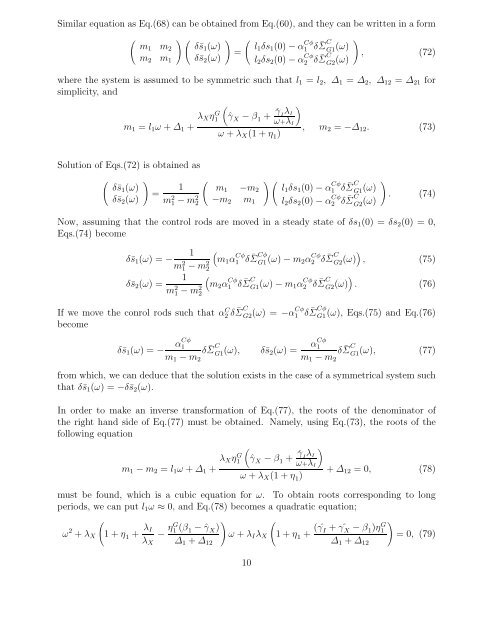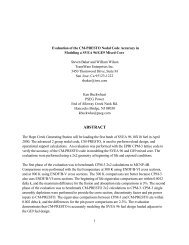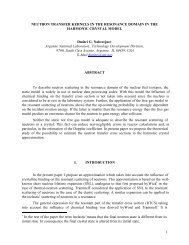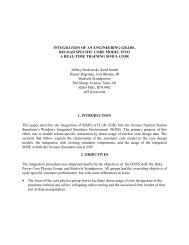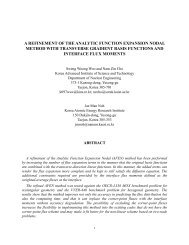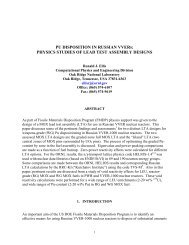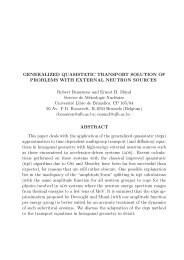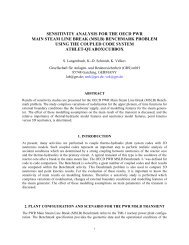K. Kobayashi and S. Tsumura
K. Kobayashi and S. Tsumura
K. Kobayashi and S. Tsumura
You also want an ePaper? Increase the reach of your titles
YUMPU automatically turns print PDFs into web optimized ePapers that Google loves.
Similar equation as Eq.(68) can be obtained from Eq.(60), <strong>and</strong> they can be written in a form<br />
<br />
m1 m2<br />
m2 m1<br />
<br />
δ¯s1(ω)<br />
δ¯s2(ω)<br />
<br />
=<br />
<br />
l1δs1(0) − α Cφ<br />
1 δ ¯ Σ C<br />
G1 (ω)<br />
l2δs2(0) − α Cφ<br />
2 δ ¯ Σ C<br />
G2(ω)<br />
<br />
, (72)<br />
where the system is assumed to be symmetric such that l1 = l2, ∆1 = ∆2, ∆12 = ∆21 for<br />
simplicity, <strong>and</strong><br />
m1 = l1ω + ∆1 +<br />
Solution of Eqs.(72) is obtained as<br />
<br />
δ¯s1(ω)<br />
δ¯s2(ω)<br />
<br />
=<br />
1<br />
m 2 1 − m 2 2<br />
λXη G 1<br />
<br />
<br />
ˆγ X − β 1 + ˆγ IλI<br />
ω + λX(1 + η 1)<br />
m1 −m2<br />
−m2 m1<br />
<br />
ω+λI<br />
<br />
, m2 = −∆12. (73)<br />
l1δs1(0) − α Cφ<br />
1 δ ¯ Σ C<br />
G1(ω)<br />
l2δs2(0) − α Cφ<br />
2 δ ¯ Σ C<br />
G2 (ω)<br />
<br />
. (74)<br />
Now, assuming that the control rods are moved in a steady state of δs1(0) = δs2(0) = 0,<br />
Eqs.(74) become<br />
1<br />
δ¯s1(ω) =−<br />
m2 1 − m2 <br />
m1α<br />
2<br />
Cφ<br />
1 δ ¯ Σ Cφ<br />
Cφ<br />
G1 (ω) − m2α2 δ ¯ Σ C<br />
G2 (ω) , (75)<br />
1<br />
δ¯s2(ω) =<br />
m2 1 − m2 <br />
m2α<br />
2<br />
Cφ<br />
1 δ ¯ Σ C<br />
G1(ω) − m1α Cφ<br />
2 δ ¯ Σ C<br />
G2(ω) <br />
. (76)<br />
If we move the conrol rods such that αC 2 δ ¯ Σ C<br />
G2(ω) =−α Cφ<br />
1 δ ¯ Σ Cφ<br />
G1(ω), Eqs.(75) <strong>and</strong> Eq.(76)<br />
become<br />
δ¯s1(ω) =− αCφ 1<br />
δ<br />
m1 − m2<br />
¯ Σ C<br />
G1 (ω), δ¯s2(ω) = αCφ 1<br />
m1 − m2<br />
δ ¯ Σ C<br />
G1 (ω), (77)<br />
from which, we can deduce that the solution exists in the case of a symmetrical system such<br />
that δ¯s1(ω) =−δ¯s2(ω).<br />
In order to make an inverse transformation of Eq.(77), the roots of the denominator of<br />
the right h<strong>and</strong> side of Eq.(77) must be obtained. Namely, using Eq.(73), the roots of the<br />
following equation<br />
m1 − m2 = l1ω + ∆1 +<br />
λXη G 1<br />
<br />
ˆγ X − β 1 + ˆγ IλI<br />
ω + λX(1 + η 1)<br />
ω+λI<br />
<br />
+ ∆12 =0, (78)<br />
must be found, which is a cubic equation for ω. To obtain roots corresponding to long<br />
periods, we can put l1ω ≈ 0, <strong>and</strong> Eq.(78) becomes a quadratic equation;<br />
ω 2 + λX<br />
<br />
1+η 1 + λI<br />
λX<br />
− ηG <br />
<br />
1 (β1 − ˆγ X)<br />
ω + λIλX 1+η1 +<br />
∆1 + ∆12<br />
(ˆγ I + γˆX − β1)η G 1<br />
∆1 + ∆12<br />
10<br />
<br />
=0, (79)


